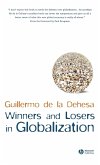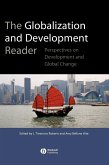Stéphane Callens
Creative Globalization
Stéphane Callens
Creative Globalization
- Gebundenes Buch
- Merkliste
- Auf die Merkliste
- Bewerten Bewerten
- Teilen
- Produkt teilen
- Produkterinnerung
- Produkterinnerung
The purpose of this book is to draw up a picture of the transformations in the innovation systems induced by globalization - or globalization. We understand the latter as the existence of new macroeconomic solidarities. These are attested since about the middle of the 1980s, with the observation of a tripolar world drawn up by Kenichi Ohmae. The book intends to explain all theories of globalization, as well as to clarify its relations with innovation. It constitutes an unprecedented synthesis on this theme, illustrated by examples from many sectors of activity.
Andere Kunden interessierten sich auch für
![Winners and Losers in Globalization Winners and Losers in Globalization]() Guillermo De La DehesaWinners and Losers in Globalization52,99 €
Guillermo De La DehesaWinners and Losers in Globalization52,99 €![Globalization and Development Reader Globalization and Development Reader]() RobertsGlobalization and Development Reader171,99 €
RobertsGlobalization and Development Reader171,99 €![What Do We Know about Globalization? What Do We Know about Globalization?]() Guillermo De La DehesaWhat Do We Know about Globalization?52,99 €
Guillermo De La DehesaWhat Do We Know about Globalization?52,99 €![Adjusting to Globalization Adjusting to Globalization]() David Greenaway (ed.)Adjusting to Globalization48,99 €
David Greenaway (ed.)Adjusting to Globalization48,99 €![Creative Complex Systems Creative Complex Systems]() Creative Complex Systems81,99 €
Creative Complex Systems81,99 €![Market-Driven Politics: Neoliberal Democracy and the Public Interest Market-Driven Politics: Neoliberal Democracy and the Public Interest]() Colin LeysMarket-Driven Politics: Neoliberal Democracy and the Public Interest19,99 €
Colin LeysMarket-Driven Politics: Neoliberal Democracy and the Public Interest19,99 €![Globalization and the Asia Pacific Economy Globalization and the Asia Pacific Economy]() Globalization and the Asia Pacific Economy202,99 €
Globalization and the Asia Pacific Economy202,99 €-
-
-
The purpose of this book is to draw up a picture of the transformations in the innovation systems induced by globalization - or globalization. We understand the latter as the existence of new macroeconomic solidarities. These are attested since about the middle of the 1980s, with the observation of a tripolar world drawn up by Kenichi Ohmae. The book intends to explain all theories of globalization, as well as to clarify its relations with innovation. It constitutes an unprecedented synthesis on this theme, illustrated by examples from many sectors of activity.
Hinweis: Dieser Artikel kann nur an eine deutsche Lieferadresse ausgeliefert werden.
Hinweis: Dieser Artikel kann nur an eine deutsche Lieferadresse ausgeliefert werden.
Produktdetails
- Produktdetails
- Verlag: Wiley
- Seitenzahl: 256
- Erscheinungstermin: 5. September 2018
- Englisch
- Abmessung: 251mm x 178mm x 18mm
- Gewicht: 454g
- ISBN-13: 9781786302274
- ISBN-10: 1786302276
- Artikelnr.: 52711271
- Herstellerkennzeichnung
- Libri GmbH
- Europaallee 1
- 36244 Bad Hersfeld
- 06621 890
- Verlag: Wiley
- Seitenzahl: 256
- Erscheinungstermin: 5. September 2018
- Englisch
- Abmessung: 251mm x 178mm x 18mm
- Gewicht: 454g
- ISBN-13: 9781786302274
- ISBN-10: 1786302276
- Artikelnr.: 52711271
- Herstellerkennzeichnung
- Libri GmbH
- Europaallee 1
- 36244 Bad Hersfeld
- 06621 890
Stéphane Callens, LEM UMR 9221 CNRS, Université d'Artois, France.
Introduction ix
Chapter 1. Globalization and Innovation: An Intellectual Landscape 1
1.1. Globalization: theoretical approaches 2
1.1.1. The "Supply" approach: Kenichi Ohmae 2
1.1.2. The "Political Action" approach: Zygmunt Bauman 5
1.1.3. The "system" approach: Ulrich Beck 8
1.1.4. Theoretical approaches before 1986 14
1.2. Industrial risks in the world: catastrophes 15
1.3. Work accidents around the world 18
1.4. Discussion 25
Chapter 2. Scaling Up 31
2.1. As societies choose 31
2.2. The sociotechnical system of the electric vehicle 33
2.2.1. Light vehicle design 34
2.2.2. Decisive factors in the electric vehicle's acceptability 37
2.3. Inglehart's postmaterialist values 40
2.3.1. Cultural values and the electric vehicle 41
2.3.2. Discussions and implications 47
2.4. Deployment of the electric vehicle and power relations 48
2.4.1. The role of territorial collectives 49
2.4.2. Ulrich Beck's "cosmopolitan communities of climate risk" 50
2.4.3. Individuality with multiple affiliations (Beck) 53
2.4.4. Electromobility 54
2.4.5. Rural and urban areas in the history of electric distribution
networks 56
2.4.6. Sustainable territorial strategies: limitations of strategies based
on space rationalization 57
2.4.7. "Technological conservatism" versus the "emancipatory catastrophe"
58
2.4.8. Where and how do climate risk communities emerge? 62
2.4.9. Efficiency of local policies 63
2.4.10. The spread of the hydrogen vehicle 64
2.5. The primary electric vehicle markets 66
2.5.1. Pioneering markets 68
2.5.2. Emerging markets 69
2.5.3. Renewal markets 70
Chapter 3. Born Global 73
3.1. Definition 73
3.2. The two worlds of born global organizations 78
3.2.1. Born global firms in regions with a majority of local
entrepreneurship 80
3.2.2. Born global firms in open regions 81
3.2.3. A convergence of organizational form 83
3.3. The born global organization: a new paradigm 84
3.3.1. Redesign of the theoretical bases: intellectual rights, learning,
intercultural distance 86
3.3.2. An entrepreneurial paradigm of simplicity 87
3.4. Collaborative economics and born global organizations 89
3.4.1. Creative destruction? 90
3.4.2. Collaborative economics and the dynamics of civic spirit 92
3.5. An economy of remoteness 96
3.5.1. Birth of the unicorn 97
3.5.2. The benefits of remoteness 98
Chapter 4. Penpushers and Hotheads 101
4.1. The curse of the company leader 101
4.2. The behavioral finance of attractiveness 103
4.2.1. Models with "heuristics and biases" 104
4.2.2. Models with preference formation 106
4.2.3. Coordination models 107
4.2.4. Argument and limits 108
4.3. The behavioral finances of venture capital 109
4.3.1. Models with heuristics and biases 112
4.3.2. Preference formation models 116
4.3.3. Coordination outside the market 117
4.3.4. The contribution of behavioral approaches to the analysis of venture
capital 119
Chapter 5. Innovation and Freedom of Circulation 121
5.1. From the dilemma to the trilemma of Myrdal 121
5.1.1. Innovation systems in globalization: a comparison of 1997/2017 123
5.1.2. Common markets: two, three and four freedoms 125
5.1.3. Innovation, spatial or social segregation in common markets 128
5.2. Multilateral management 133
5.2.1. Migration, wage and commerce: a review of the literature 135
5.2.2. Citizenship around the world 139
5.2.3. Institutional outlines of multilateral management 147
5.2.4. Citizenship and innovation 148
Conclusion 153
Bibliography 171
Data sources 189
Index 193
Chapter 1. Globalization and Innovation: An Intellectual Landscape 1
1.1. Globalization: theoretical approaches 2
1.1.1. The "Supply" approach: Kenichi Ohmae 2
1.1.2. The "Political Action" approach: Zygmunt Bauman 5
1.1.3. The "system" approach: Ulrich Beck 8
1.1.4. Theoretical approaches before 1986 14
1.2. Industrial risks in the world: catastrophes 15
1.3. Work accidents around the world 18
1.4. Discussion 25
Chapter 2. Scaling Up 31
2.1. As societies choose 31
2.2. The sociotechnical system of the electric vehicle 33
2.2.1. Light vehicle design 34
2.2.2. Decisive factors in the electric vehicle's acceptability 37
2.3. Inglehart's postmaterialist values 40
2.3.1. Cultural values and the electric vehicle 41
2.3.2. Discussions and implications 47
2.4. Deployment of the electric vehicle and power relations 48
2.4.1. The role of territorial collectives 49
2.4.2. Ulrich Beck's "cosmopolitan communities of climate risk" 50
2.4.3. Individuality with multiple affiliations (Beck) 53
2.4.4. Electromobility 54
2.4.5. Rural and urban areas in the history of electric distribution
networks 56
2.4.6. Sustainable territorial strategies: limitations of strategies based
on space rationalization 57
2.4.7. "Technological conservatism" versus the "emancipatory catastrophe"
58
2.4.8. Where and how do climate risk communities emerge? 62
2.4.9. Efficiency of local policies 63
2.4.10. The spread of the hydrogen vehicle 64
2.5. The primary electric vehicle markets 66
2.5.1. Pioneering markets 68
2.5.2. Emerging markets 69
2.5.3. Renewal markets 70
Chapter 3. Born Global 73
3.1. Definition 73
3.2. The two worlds of born global organizations 78
3.2.1. Born global firms in regions with a majority of local
entrepreneurship 80
3.2.2. Born global firms in open regions 81
3.2.3. A convergence of organizational form 83
3.3. The born global organization: a new paradigm 84
3.3.1. Redesign of the theoretical bases: intellectual rights, learning,
intercultural distance 86
3.3.2. An entrepreneurial paradigm of simplicity 87
3.4. Collaborative economics and born global organizations 89
3.4.1. Creative destruction? 90
3.4.2. Collaborative economics and the dynamics of civic spirit 92
3.5. An economy of remoteness 96
3.5.1. Birth of the unicorn 97
3.5.2. The benefits of remoteness 98
Chapter 4. Penpushers and Hotheads 101
4.1. The curse of the company leader 101
4.2. The behavioral finance of attractiveness 103
4.2.1. Models with "heuristics and biases" 104
4.2.2. Models with preference formation 106
4.2.3. Coordination models 107
4.2.4. Argument and limits 108
4.3. The behavioral finances of venture capital 109
4.3.1. Models with heuristics and biases 112
4.3.2. Preference formation models 116
4.3.3. Coordination outside the market 117
4.3.4. The contribution of behavioral approaches to the analysis of venture
capital 119
Chapter 5. Innovation and Freedom of Circulation 121
5.1. From the dilemma to the trilemma of Myrdal 121
5.1.1. Innovation systems in globalization: a comparison of 1997/2017 123
5.1.2. Common markets: two, three and four freedoms 125
5.1.3. Innovation, spatial or social segregation in common markets 128
5.2. Multilateral management 133
5.2.1. Migration, wage and commerce: a review of the literature 135
5.2.2. Citizenship around the world 139
5.2.3. Institutional outlines of multilateral management 147
5.2.4. Citizenship and innovation 148
Conclusion 153
Bibliography 171
Data sources 189
Index 193
Introduction ix
Chapter 1. Globalization and Innovation: An Intellectual Landscape 1
1.1. Globalization: theoretical approaches 2
1.1.1. The "Supply" approach: Kenichi Ohmae 2
1.1.2. The "Political Action" approach: Zygmunt Bauman 5
1.1.3. The "system" approach: Ulrich Beck 8
1.1.4. Theoretical approaches before 1986 14
1.2. Industrial risks in the world: catastrophes 15
1.3. Work accidents around the world 18
1.4. Discussion 25
Chapter 2. Scaling Up 31
2.1. As societies choose 31
2.2. The sociotechnical system of the electric vehicle 33
2.2.1. Light vehicle design 34
2.2.2. Decisive factors in the electric vehicle's acceptability 37
2.3. Inglehart's postmaterialist values 40
2.3.1. Cultural values and the electric vehicle 41
2.3.2. Discussions and implications 47
2.4. Deployment of the electric vehicle and power relations 48
2.4.1. The role of territorial collectives 49
2.4.2. Ulrich Beck's "cosmopolitan communities of climate risk" 50
2.4.3. Individuality with multiple affiliations (Beck) 53
2.4.4. Electromobility 54
2.4.5. Rural and urban areas in the history of electric distribution
networks 56
2.4.6. Sustainable territorial strategies: limitations of strategies based
on space rationalization 57
2.4.7. "Technological conservatism" versus the "emancipatory catastrophe"
58
2.4.8. Where and how do climate risk communities emerge? 62
2.4.9. Efficiency of local policies 63
2.4.10. The spread of the hydrogen vehicle 64
2.5. The primary electric vehicle markets 66
2.5.1. Pioneering markets 68
2.5.2. Emerging markets 69
2.5.3. Renewal markets 70
Chapter 3. Born Global 73
3.1. Definition 73
3.2. The two worlds of born global organizations 78
3.2.1. Born global firms in regions with a majority of local
entrepreneurship 80
3.2.2. Born global firms in open regions 81
3.2.3. A convergence of organizational form 83
3.3. The born global organization: a new paradigm 84
3.3.1. Redesign of the theoretical bases: intellectual rights, learning,
intercultural distance 86
3.3.2. An entrepreneurial paradigm of simplicity 87
3.4. Collaborative economics and born global organizations 89
3.4.1. Creative destruction? 90
3.4.2. Collaborative economics and the dynamics of civic spirit 92
3.5. An economy of remoteness 96
3.5.1. Birth of the unicorn 97
3.5.2. The benefits of remoteness 98
Chapter 4. Penpushers and Hotheads 101
4.1. The curse of the company leader 101
4.2. The behavioral finance of attractiveness 103
4.2.1. Models with "heuristics and biases" 104
4.2.2. Models with preference formation 106
4.2.3. Coordination models 107
4.2.4. Argument and limits 108
4.3. The behavioral finances of venture capital 109
4.3.1. Models with heuristics and biases 112
4.3.2. Preference formation models 116
4.3.3. Coordination outside the market 117
4.3.4. The contribution of behavioral approaches to the analysis of venture
capital 119
Chapter 5. Innovation and Freedom of Circulation 121
5.1. From the dilemma to the trilemma of Myrdal 121
5.1.1. Innovation systems in globalization: a comparison of 1997/2017 123
5.1.2. Common markets: two, three and four freedoms 125
5.1.3. Innovation, spatial or social segregation in common markets 128
5.2. Multilateral management 133
5.2.1. Migration, wage and commerce: a review of the literature 135
5.2.2. Citizenship around the world 139
5.2.3. Institutional outlines of multilateral management 147
5.2.4. Citizenship and innovation 148
Conclusion 153
Bibliography 171
Data sources 189
Index 193
Chapter 1. Globalization and Innovation: An Intellectual Landscape 1
1.1. Globalization: theoretical approaches 2
1.1.1. The "Supply" approach: Kenichi Ohmae 2
1.1.2. The "Political Action" approach: Zygmunt Bauman 5
1.1.3. The "system" approach: Ulrich Beck 8
1.1.4. Theoretical approaches before 1986 14
1.2. Industrial risks in the world: catastrophes 15
1.3. Work accidents around the world 18
1.4. Discussion 25
Chapter 2. Scaling Up 31
2.1. As societies choose 31
2.2. The sociotechnical system of the electric vehicle 33
2.2.1. Light vehicle design 34
2.2.2. Decisive factors in the electric vehicle's acceptability 37
2.3. Inglehart's postmaterialist values 40
2.3.1. Cultural values and the electric vehicle 41
2.3.2. Discussions and implications 47
2.4. Deployment of the electric vehicle and power relations 48
2.4.1. The role of territorial collectives 49
2.4.2. Ulrich Beck's "cosmopolitan communities of climate risk" 50
2.4.3. Individuality with multiple affiliations (Beck) 53
2.4.4. Electromobility 54
2.4.5. Rural and urban areas in the history of electric distribution
networks 56
2.4.6. Sustainable territorial strategies: limitations of strategies based
on space rationalization 57
2.4.7. "Technological conservatism" versus the "emancipatory catastrophe"
58
2.4.8. Where and how do climate risk communities emerge? 62
2.4.9. Efficiency of local policies 63
2.4.10. The spread of the hydrogen vehicle 64
2.5. The primary electric vehicle markets 66
2.5.1. Pioneering markets 68
2.5.2. Emerging markets 69
2.5.3. Renewal markets 70
Chapter 3. Born Global 73
3.1. Definition 73
3.2. The two worlds of born global organizations 78
3.2.1. Born global firms in regions with a majority of local
entrepreneurship 80
3.2.2. Born global firms in open regions 81
3.2.3. A convergence of organizational form 83
3.3. The born global organization: a new paradigm 84
3.3.1. Redesign of the theoretical bases: intellectual rights, learning,
intercultural distance 86
3.3.2. An entrepreneurial paradigm of simplicity 87
3.4. Collaborative economics and born global organizations 89
3.4.1. Creative destruction? 90
3.4.2. Collaborative economics and the dynamics of civic spirit 92
3.5. An economy of remoteness 96
3.5.1. Birth of the unicorn 97
3.5.2. The benefits of remoteness 98
Chapter 4. Penpushers and Hotheads 101
4.1. The curse of the company leader 101
4.2. The behavioral finance of attractiveness 103
4.2.1. Models with "heuristics and biases" 104
4.2.2. Models with preference formation 106
4.2.3. Coordination models 107
4.2.4. Argument and limits 108
4.3. The behavioral finances of venture capital 109
4.3.1. Models with heuristics and biases 112
4.3.2. Preference formation models 116
4.3.3. Coordination outside the market 117
4.3.4. The contribution of behavioral approaches to the analysis of venture
capital 119
Chapter 5. Innovation and Freedom of Circulation 121
5.1. From the dilemma to the trilemma of Myrdal 121
5.1.1. Innovation systems in globalization: a comparison of 1997/2017 123
5.1.2. Common markets: two, three and four freedoms 125
5.1.3. Innovation, spatial or social segregation in common markets 128
5.2. Multilateral management 133
5.2.1. Migration, wage and commerce: a review of the literature 135
5.2.2. Citizenship around the world 139
5.2.3. Institutional outlines of multilateral management 147
5.2.4. Citizenship and innovation 148
Conclusion 153
Bibliography 171
Data sources 189
Index 193








